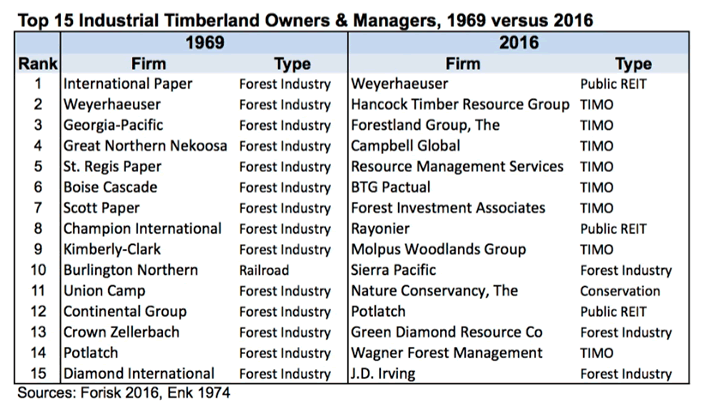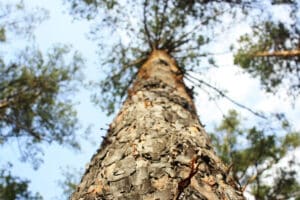In 1969, Neil Armstrong became the first person to walk on the moon. He found that trees do not grow on there; as a souvenir, he brought home a rock and confirmed that things change slowly without an atmosphere. On Earth that year, we struggled with Vietnam and civil unrest, even as Joe Namath won a Super Bowl for the New York Jets and later shaved his legs for a television commercial.
In forestry, a timber ownership era was starting to fade. In 1969, 14 of the 15 largest U.S. timberland owners were vertically-integrated, mill-owning, forest industry firms. Now, in 2016, while Joe Namath remains the only quarterback to win a Super Bowl for the Jets, only two of the top timberland owners from 1969 hold places on the list in 2016.
Industrial Timberland Ownership Changes
In the forthcoming book “Liquid Trees: Forests as Financial Assets”, we describe how the concentration and conversion among the largest timberland owners and managers accelerated over the past five decades. The table below compares the top U.S. owners and managers, in order by acreage, from 1969 to 2016. What started as a sector dominated by integrated forest industry firms now features timberland specialists (in the form of REITs) and asset managers.

While the institutional timberland investment sector came of age in the 1980s, timber REITs hit the market in 1999 beginning with the conversion of Plum Creek from a master limited partnership (MLP) to a REIT. Between 1999 and 2006, four publicly-traded forest products firms converted over 12 million acres of industrial timberlands into corporate structures called REITs. In addition to Plum Creek, these firms included Rayonier, Potlatch and, for less than one year, Longview Fiber. Weyerhaeuser made the conversion in 2010. In December 2013, CatchMark Timber Trust, formerly the private REIT known as Wells Timber, became the sixth public timber REIT.
While six timber REITs have traded publicly since 1999, we are left with four today. Timberland investors looking to acquire assets and timber REITs seeking to grow their asset bases both made big moves over the past 18 months. Firms in Forisk’s North American Timberland Owner & Manager List were among those that conducted at least 92 publicly known timberland transactions totaling over 9.8 million acres, including 29 transactions that exceeded 20,000 acres each.
The presence of TIMOs and REITs as both buyers and sellers continues to speak to the relative maturity of the sector, as investors continue to grapple with the reality of a constrained “solution set” of opportunities. Moving forward, the world of timberland investing will continue to struggle with within-industry maturity and outside-of-industry demand for returns.
This content may not be used or reproduced in any manner whatsoever, in part or in whole, without written permission of LANDTHINK. Use of this content without permission is a violation of federal copyright law. The articles, posts, comments, opinions and information provided by LANDTHINK are for informational and research purposes only and DOES NOT substitute or coincide with the advice of an attorney, accountant, real estate broker or any other licensed real estate professional. LANDTHINK strongly advises visitors and readers to seek their own professional guidance and advice related to buying, investing in or selling real estate.










Add Comment